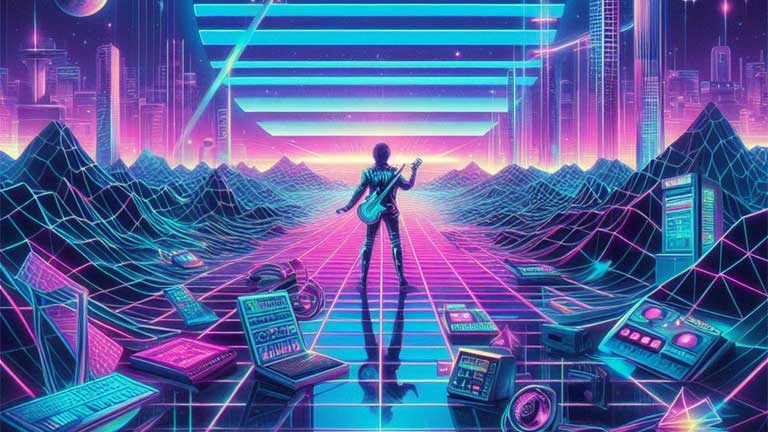
Vaporwave is an internet subculture that emerged in the 2010s. It is a microgenre of electronic music, a visual art style, and an internet meme characterized by a nostalgic engagement with pop culture, namely consumer capitalism.
It is, therefore, not surprising that brands play an essential role in vaporwave, whether through corporate logos taking center stage in amateur Photoshop collages or their ecstatic aestheticization in pastel nihilistic collages.
Music
Vaporwave is a genre of electronic music that combines old and new styles. The resulting combination is strange and melancholy. Its name reflects the genre’s aesthetic, combining elements from both vapor and wave (as in the light frequencies of a radio signal or the movement of liquid).
While vaporwave was primarily inspired by other music types like chillwave, psychedelic, or hypnagogic pop and is closely related to synthesizer loops, its unique style separates it from the rest. The main difference is that it runs at a much lower tempo, usually below 90 bpm. The music is often accompanied by visuals such as pink or purple neon lights, synthetic sunsets, palm trees, dolphins, and Greek busts. It also features corporate imagery such as Microsoft Windows, Apple Macintosh Plus, and Arizona Iced Tea logos. It is a very nostalgic genre, often drawing upon millennials’ nostalgia for their youth and childhood.
This nostalgia has caused a melancholy in vaporwave and its many subgenres, such as minor soft, future funk, and hard vapor. It has also influenced the political affiliations of the scene, with alt-right sympathy for fascism and racism tainting its popularity and growth. The genre eventually began splintering into smaller subgenres with different production methods and artistic interpretations.
Texture
Vaporwave is a style that takes more work to pin down. From the outside looking in, it appears to be a fever dream of electric colors, Japanese characters, and 90’s nostalgia, but those deeply entrenched in this subculture see it differently.
For them, it is about the memories buried in our subconscious and how to access them using digital means of expression. It is a nostalgic style meant to be both eerie and comforting. The aesthetic uses a variety of repurposed images and videos from decades past, incorporating elements of web design from the early days of the Internet as well as old music videos and even McDonalds ads (which birthed another subgenre of Vaporwave called simpsonwave).
As for the musical elements, it often samples loungy elevator muzak, television advertisements, infomercials, and video game sounds. These are all manipulated and slowed down to create a dreamlike state of consciousness and a calming and hypnotic atmosphere.
The visual art of vaporwave has its roots in surrealism, an interwar movement that explored the unconscious to unlock creativity and a sense of unease.
Visual Aesthetics
Vaporwave is more than just music; it’s an entire subculture encompassing visual art, memes, and culture. The vaporwave music genre takes inspiration from everything from the ’80s to modern technology. It is a mix of nostalgia and satire of consumerism and corporate society.
The aesthetics of early computer graphics and glitch art inspired the style; vaporwave was also influenced by the color palettes of the ’80s and early internet culture and the remixing, slowing, and reverberating of elevator-type music.
While the music of vaporwave often evokes a sense of loneliness and isolation, its visual aesthetics are more about nostalgia and dreamscapes. The genre combines retro imagery with digital effects and filters to create a melancholy and psychedelic atmosphere. Typical visual elements include digitally altered pictures of landscapes, cityscapes, and iconic symbols.
Its imagery and soundscapes are influenced by the uncanny valley, the phenomenon that humans find human-like objects more appealing until they become too much like themselves. This unsettling feeling is often echoed in vaporwave music as it uses electronic synthesizers and drum machines to create a synthetic, robotic sound.
Since the emergence of Vaporwave in 2011, the scene has splintered into a myriad of sub-genres.
Symbolism
The most prevalent visual theme of vaporwave is an aesthetic of unreality. As the name suggests, vaporwave artists are often attracted to technology as symbols of childhood nostalgia and escape from a harsher, more modern reality. It is also evident in using computer game iconography in cover art. However, the systems portrayed in these icons never belong to contemporary, state-of-the-art consoles; they are always vintage models. It signifies that Vaporwave is less interested in video games and more in the aura surrounding them.
The same idea of escaping from reality is reflected in the genre’s obsession with blurry imagery.
Musically, vaporwave is characterized by airy synthesizer pads and programmed percussion. It often uses samples of smooth jazz, corporate muzak, and old TV shows to reinforce its ironic sense of nostalgia from the early 1990s. These samples are slowed down, chopped, and screwed to create a surreal warping effect.
Vaporwave also tends to depict Asian and Japanese scenery, most noticeably in the form of blurry cityscapes. It can come close to sinning Orientalism, but it is also an attempt to transform our world into one that is more in line with virtual realities.




